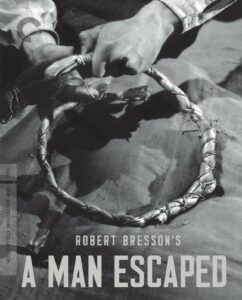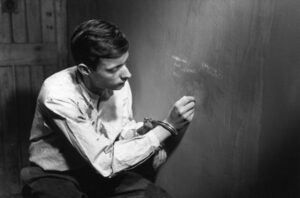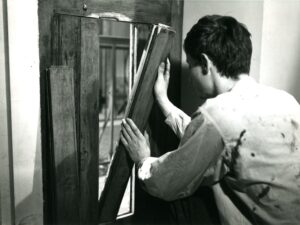“A Man Escaped” – Apotheosis of the Pursuit of Freedom

Title: “A Man Escaped” (“Un condamné à mort s’est échappé ou Le vent souffle où il veut”)
Release Date: 1956
Director: Robert Bresson
Cast: François Leterrier, Charles Le Clainche, Maurice Beerblock
“A Man Escaped” is one of Robert Bresson’s most famous films. Based on a true story, the tale of the improbable feat of a French lieutenant who escaped from a Nazi prison one day before his death sentence, is the apotheosis of the idea of freedom. What’s more, the almost ascetic means of expression and the minimization of the actor’s expression here create an evocative whole that opens up to metaphysical senses.
“A Man Escaped” – a story based on fact
“A Man Escaped” from 1956 Robert Bresson based on the true story of Lieutenant André Devigny, who in 1943 escaped from a German prison in Lyon’s Montluc. The soldier escaped from his cell just before he was scheduled to be executed, a fact that reverberated throughout France. The film begins when the man tries to escape from a car driven by Gestapo officers, but is overpowered and beaten. When he recovers after a few days, he begins to devise an escape plan. After carefully inspecting the cell, he decides to force the wooden door with a chisel, which he makes from an aluminum spoon. During his short walks, the protagonist establishes helpful relationships with his fellow inmates, and communicates with them using sound signals.
Eventually, the painstaking work yields results, but just before the planned escape, a young prisoner is assigned to Fontaine’s cell. The man has no idea whether he can trust him and suspects that the boy is a spy sent by the Germans after fruitless interrogations in which he failed to divulge any useful information. In the end, however, Fontaine decides to initiate his fellow prisoner into his plan and take him with him. At night, they remove the boards from the door and climb up to the roof, overcoming one obstacle after another. To operate, they use the sound of passing trains to drown out their noises. After long hours, they manage to get behind the fortress walls and escape.

Bresson’s cinematic method in “A Man Escaped”
The movie “A Man Escaped” is an exemplary example of Bresson’s cinema. Therefore, we are dealing here with an extreme simplification of means of expression both in terms of plot and character creation. It is noteworthy that the protagonist was deprived of individual characteristics, despite the fact that the story was based on real events. In the film he bears the name Fontaine and is a Resistance activist or simply a man. Although the picture is constantly accompanied by the character’s inner monologue, we do not learn anything about the man’s past, and it is also difficult to infer anything about his character. All we get is a report on his plans for escape and an account of his activities. Interestingly, Bresson, in order to intensify the impression of authenticity, did not employ professional actors in his films, but entrusted the roles to naturalists, insisting that they speak their lines freely, without a shadow of mannerism.
Asceticism is the principle of “A Man Escaped” also in the sphere of action, which is impressive not thanks to unexpected twists and turns, but by the peculiar monotony of daily existence in prison. It is determined, namely, by the rhythm of meals, short walks and toilets, and, above all, by the long hours of incapacitating isolation. Bresson makes equally sparing use of music, although sound plays a key role in the film. Hearing becomes one of Fontaine’s most important senses as he picks out individual tones, learns to interpret and use them. There is the acoustics of neighboring cells, allowing prisoners to communicate, the clanking of guards’ keys, the distant signals of passing trains or the sound of footsteps on the stairs. Individual situations are highlighted only by Mozart’s eloquent music. The picture, on the other hand, captures the point of view of the characters, the camera does not leave the protagonist even for a moment, reporting only what he himself can see.

“A Man Escaped” and the metaphysical desire for freedom
“A Man Escaped” is first and foremost a film about the overwhelming desire for freedom. The viewer during the screening identifies with the protagonist, experiences the drama of prison life and, like him, focuses on the effort to get out of confinement. Bresson dedicated the film to all the victims of the Nazi prison. In addition to literal meanings, the picture also contains a parabolic message, suggested by the everyman character and the labyrinthine construction of the space. Fontaine’s situation can be read as an allegorical image of any kind of enslavement – mental, addiction or other life situations that seemingly have no way out and make us feel trapped. Believing in the possibility of escape, focusing on tiny but successive steps and searching for kindred souls prove more important than other seemingly more useful tools.
It should also be emphasized that “A Man Escaped” opens to the metaphysical realm. It is already suggested by the significant antinomy of sound and silence, which tells most about the fate of those who were murdered. Supernatural references, on the other hand, resound especially strongly in the film’s triumphant ending with Mozart’s mass, when the free heroes walk away into the distance shrouded in the mist of the rising dawn.
Literature:
„Kino klasyczne”, pod red. T. Lubelskiego, I. Sowińskiej i R. Syski, Kraków 2012.
A.Garbicz, J. Klinowski, „Kino, wehikuł magiczny. Podróż druga 1950 – 1959”, Kraków 1987.
